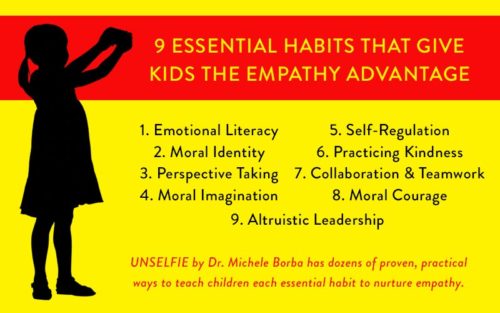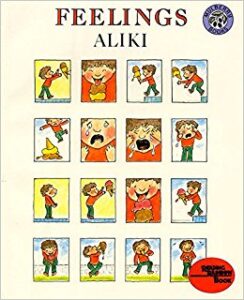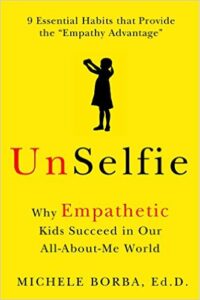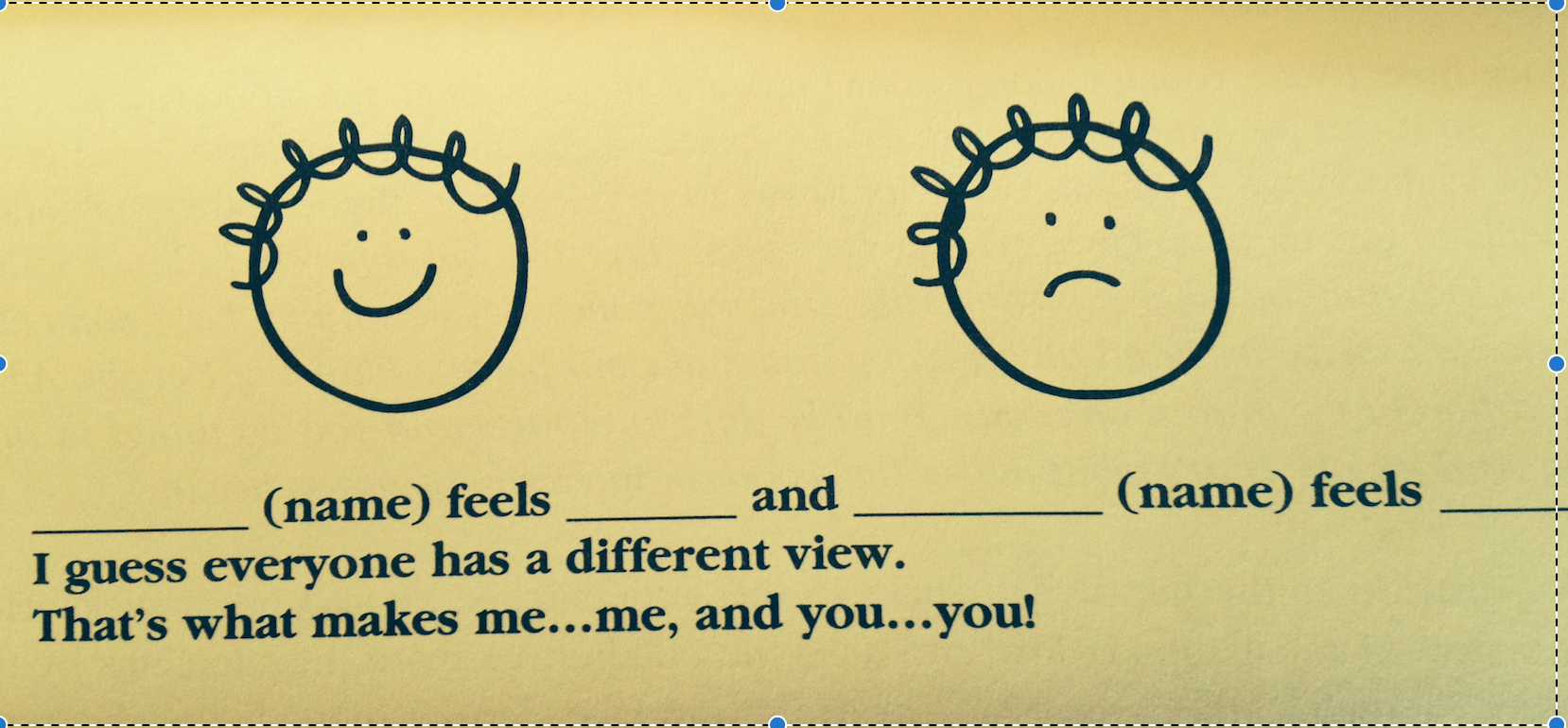Ways to Help Children Learn Emotional Literacy
Your two-year-old looks at the tears in your eyes and gently pats your face. Your school-age child sees that his friend is sad and gently puts his arm on his shoulder and tells him, “It’s okay. It’ll get better.” Your tween notices that your father’s face seems strained: “Are you tired, Grandpa? Need a hug?”
All these are examples of emotional literacy—the ability to identify an emotion in yourself or others. It’s the first, and arguably most crucial, of the nine essential habits of empathy from my latest book UnSelfie: Why Empathetic Kids Succeed in Our All About Me World. The habits are the tools that will give your child the Empathy Advantage for future happiness and success. And emotional literacy is the essential key to unlocking empathy.
Before you can empathize, you have to be able to read someone else’s, or your own, emotions so you can tune in to their feelings. (“She is smiling . . . I bet she’s happy?” “Her body is slumped over . . . maybe she’s tired.” “I’m sad because he’s sad. . . .”) Emotional literacy is what motivates a child to care, and it all starts by tuning in to feelings. Identifying, under- standing, and expressing emotions are the skills kids need to activate empathy.
The great news is that emotional literacy is not just a gift; it’s actually an ability that can be taught to our children, starting when they are young as toddlers . . . though the seeds are planted even earlier, by how we relate and respond to our infants.
In our hyper-connected, social-media-saturated society, many kids are so obsessed with snapping “selfies” and living a virtual life online that they’re not tuning into the people right in front of them IRL (that’s “in real life.”). And so they’re robbed of those moments to learn emotional literacy: hearing the tone of feelings, seeing the distress, happiness, anger, frustration, joy or whatever else on another’s face or in their body language. And it’s one reason why kids empathy is 40 percent lower in 30 years. But the good news is that empathy can be cultivated in children, and it all starts with emotional literacy.
Here are ten tips to nurture emotional literacy The book provides over 300 science-backed age-by-age tips to teach kids nine crucial empathy habits they’ll need for real happiness, success, and resilience, and to care about others. I’ve also listed the page numbers to find each tip that follows below.

1. Be An Emotion Coach
Find natural moments to connect face to face to listen, and then validate your child’s feelings and boost emotional literacy. The face is the best tool for developing emotional literacy. For more ideas, read John Gottman’s The Heart of Parenting: Raising an Emotionally Intelligent Child or page 15-16 in Unselfie.
2. Talk Feelings
Kids need an emotion vocabulary to discuss feelings and guidance to become emotionally literate.
Labeling feelings goes hand in hand with empathy and helps kids build a feeling vocabulary. So: 1. Name feelings: “Looks like you’re angry.” “You seem frustrated.” “You sound irritated.” 2. Point out feelings in films, books, or real people and use more emotion words. 3. Pose questions that tune in to feelings. “Are you angry [tense, anxious, worried, frustrated]?” 4. Match the emotion with the gesture. “You seem to be scowling. Are you tired?” “Your fists are clenched. Do you feel anxious?” The key is to talk about feelings more naturally with your children. (See pages 16-18)
3. Teach: “Always look at the color of the talker’s eyes.”
Eye contact is how kids learn to read people’s emotions, so face your child and be at eye level when you communicate. Then enforce one habit: “Always look at the color of the talker’s eyes.” The rule helps kids use eye contact and pick up facial expressions, voice tone, and emotional cues. Holding eye staring contests to see how long family members can maintain eye contact without breaking their stare is a fun way to help kids feel more comfortable looking at one another. If your child is uncomfortable using eye contact, suggest, “Look at the bridge of the speaker’s nose.” (See page 17).
3. Raise a Puppy (or Borrow One)
Are your kids begging for a puppy? Animals can be powerful subjects to teach emotions: “Watch Fido’s tail. What do you think he’s saying?” (You can always borrow the neighbor’s pets). Or: “How do you know if he’s is scared?” Could your older child volunteer at an animal shelter? Is there an animal your child could care for, train, and then observe its emotions? You can also use a baby, a kitty, or brother, sister Grandma, Daddy to help kids tune into another’s feelings. (See page 16).
4. Set Unplugged Times
Periodically check your home cell phone records, emails, texts, tweet logs, and television, video game, tablet, and computer use. How much time is your family currently plugged in on a typical day? Is a digital “realignment” needed in your home that would allow more face-to-face time? If so, plan it! Then stick to your rules so kids have “face time.” (See pages 22-23)
5. Skype or FaceTime with Grandma
Skyping or FaceTiming is a great way kids can connect with loved ones face-to-face. Reflecting about their caller’s emotional state prior to the Skype helps nurture empathy. “How will you know how she feels?” “Do you think Grandma will be tired like last time? What signs on her face tell you it’s time to end the call?”
6. Eat Together, Hold Family Meetings or Regular Chats
Studies show that the simple act of having a relaxed family meal together several times a week—with no digital devices—can positively a affect kids’ social and emotional development as well as academic performance. At least one night a week, have a dinner chat that includes discussing each member’s feelings during the day. A basket of emotion cards can be pulled to designate the topic. Pick a feeling—such as “proud”—and ask, “What was the proudest moment you had this week?” Everyone takes turns sharing his or her experience, starting with the opener: “I felt proud this week when . . .” Some families vote as to who had the most interesting (unusual, frustrating, exciting, different) experience. You can also turn the strategy into a fun bedtime routine or use it in the car where kids are locked in with you.
 7. Use Literature and Film
7. Use Literature and Film
Find a book about feelings, and as you read with your child pair the character’s face with the appropriate emotion. Suppose you’re reading Llama Llama Red Pajama, and you come to where Baby Llama’s expression depicts his fear that Mama Llama’s not there. It’s a perfect spot to tune in to feeling. Ask: “How does Baby Llama’s face look? Why is he afraid? Make your face look afraid like Baby Llama’s. Have you ever been afraid like that?” Other book favorites are: Glad Monster, Sad Monster: A Book About Feelings, by Ed Emberley and Anne Miranda; Feelings, by Aliki; and My Many Colored Days, by Dr. Seuss. (page 23)
Click here for a list of 50 fabulous books for toddlers to teens that boost empathy.
8. Watch Silent Pictures
Turn on the television sound for a few minutes and try guessing together how the actors feel based on their body language. Nail biting and hair twirling can mean “She’s tense!” A clenched jaw could signify “He’s scared!” Rolling eyes and facing away from the speaker might mean “She’s not interested.” Nodding and leaning in mean “She’s interested!” (page 21).
Click here for a list of 100 films that boost the nine crucial empathy habits in children and teens.
9. Be “Feeling Detectives”
Help your child associate facial expressions and body language with certain emotions by watching other people’s faces and body language at the shopping mall, grocery store, park, or playground. en try together to guess their emotional state without hearing the conversation: “How does her body look now? How do you think she feels?” “Listen to the boy’s voice. How do you think he feels?” “Look how that girl has her fists so tight. See the scowl on her face? What do you think she’s saying to the other girl?” (See page 22).
10. Create a “How do you feel?” Card
Rachel Simmons, author of Odd Girl Out, finds many adolescent girls (and, I’m sure, boys) have trouble expressing feelings to peers. Simmons’s solution in her Girls Leadership Institute is giving each girl a “How Do You Feel?” card that depicts twenty faces of different emotions (like confused, panicked, anxious, betrayed, guilty, used, insecure, jealous). Each girl points to the face that depicts her feeling, and Simmons says it helps both girls “open up” and begin reconciliation. Check online for cards of “feeling faces” to print out, or have your child cut faces from magazines and glue onto cards. It also may be handy to ease a ti or open communication with a family member. (See page 23).
Tuning in to feelings is an essential part of good parenting. And this first and most crucial empathy habit lays the groundwork for developing close relationships with our kids, and it gives them the ability to relate to and feel empathy for others. We can teach children how to identify and recognize feelings in someone else, but it all begins with tuning in to another person. So keep tuning in!
All the best on raising strong, caring children who want to better the world!
Dr. Michele Borba, Educational Psychologist and Parenting Expert

Read my blog, Dr. Borba’s Reality Check for ongoing parenting solutions, educational strategies and late-breaking news about child development, empathy building and social and emotional learning (SEL).
My new book, UNSELFIE: Why Empathetic Kids Succeed in Our All-About-Me World has dozens of proven ways to build our children’s capacity for empathy and humanness. My goal is to create a conversation that makes us rethink or view of success as exclusively grades, rank and score and includes traits of humanity! It’s filled with common-sense solutions based on the latest science to help us raise compassionate, caring, courageous kids. It’s time to include “empathy” in our parenting and classrooms!


